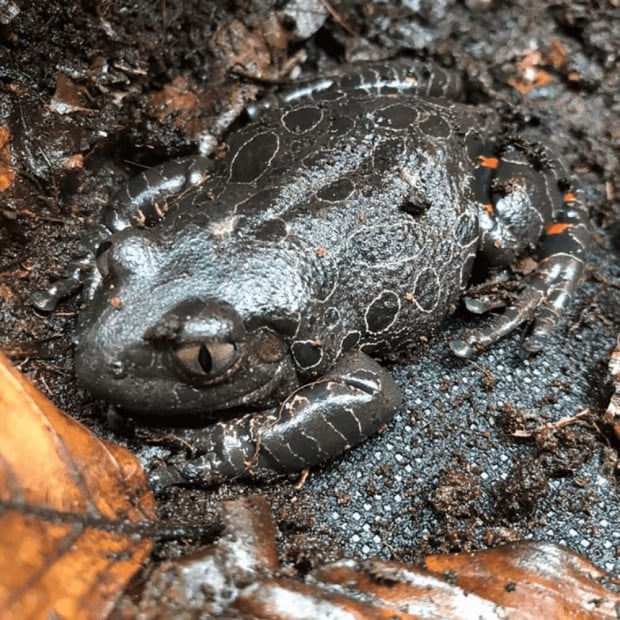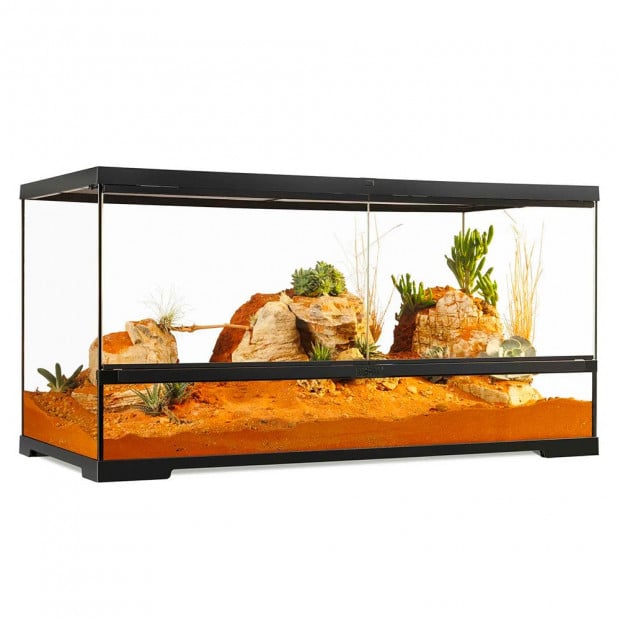Bumblebee toad, Melanophryniscus stelzneri
Bumblebee toads are an active and interesting pet that is suitable for beginners

- Bumblebee toads are diurnal and very active toads
- Communal species that can be kept in groups
- Easy husbandry requirements making them beginner-friendly
Do Bumblebee toads make good pets?
Bumblebee toads are a communal species of South American toad. In nature, they inhabit woodland and grassland habitats which are notably drier than the rainforests where the majority of popular South American species can be found. Bumblebee toads are diurnal and very active, which makes them great display animals as they tend to be out and on show the majority of the time.
At Swell Reptiles, all of our Bumblebee toads are captive bred in the UK, meaning you can rest assured your new pet came from a reliable source, without impacting their native ecosystem in a negative way.
Which enclosure should I get for my Bumblebee toads?
We recommend a minimum enclosure size of 90 x 45 x 45cm (36 x 18 x 18”) for a group of 5-6 Bumblebee toads, for example the Exo Terra Glass Terrarium 90x45x45cm. Due to their lower humidity requirements than most amphibians, a wooden vivarium, such as the VivExotic Viva+ Terrestrial Vivarium Medium could also be used, but it is still worth using vivarium sealant on the inside joins to prevent moisture from seeping in and damaging the boards.
Do Bumblebee toads need to be heated?
In nature, Bumblebee toads are subject to a variety of temperatures, making them quite a hardy species where temperature is concerned. In captivity, it is best to keep them at a happy medium and avoid extreme hot or cold temperatures, so a warm area of around 24°C (75°F) and a cool area between 15-18°C (59-64°F) is ideal. It is unlikely that any additional heating equipment will be required to maintain these temperatures, but if it is, a heat mat hooked up to an on/off thermostat will do the job.
Do Bumblebee toads need UVB?
Bumblebee toads would regularly be exposed to sunlight in nature, and should be kept in captivity with a UVI between 1-2 to ensure adequate vitamin D3 synthesis and calcium assimilation. This is most easily achieved using an Arcadia ShadeDweller ProT5 Kit positioned 25-40cm (10-15”) above the basking zone, or an Arcadia ProT5 Kit - Forest 6% positioned 40-45cm (15-18”) above the basking zone.
How do I decorate a Bumblebee toad terrarium?
To begin with, a loose, soil-based substrate such as coco soil, or a planting medium such as Arcadia EarthMix should be used for Bumblebee toads. The substrate layer can then be topped with natural reptile decor such as mosses, leaf litter and botanicals, to assist with humidity levels and also to give a more natural look to the set-up overall. Other pieces of decor such as hiding caves, logs, rocks and cork bark should also be added to provide cover and enrichment.
What do Bumblebee toads eat?
Bumblebee Toads are insectivores and feed primarily on live fruit flies from a young age to full maturity. To ensure that your Toad gets all of the nutrients required to remain healthy, all flies offered to them must be dusted with supplements according to a feeding schedule.
Here, we recommend using a calcium-rich multivitamin on every feed, such as Arcadia EarthPro-A, a calcium plus magnesium supplement on every fourth feed, such as Arcadia CalciumPro Mg and finally, a vitamin D3 supplement on every eighth feed such as Arcadia EarthPro RevitaliseD3 and finally, a vitamin a reptile supplement on every 12th feed, which is particularly important for most amphibians.
Can I Handle my Bumblebee toad?
Amphibians are characterised by a semi-permeable skin membrane across which they absorb water and other substances, this means that handling them can cause irritation to their skin due to the many substances often found on human skin, such as salts or oils that will be absorbed over the epidermis, so handling should be avoided wherever possible.
There are instances where handling cannot be avoided, for example when rehousing your Bumblebee toads. In these instances, handling should be done with clean, damp hands, or clean gloves, and should be done as quickly as possible to minimise stress and possible skin irritation.
How do I buy a Bumblebee toad?
If you would like to purchase one of our UK captive bred Bumblebee toads, please come into our superstore and see us. We will ask a few quick questions and also to see some images of your set-up which should be completely ready for the toad(s) to go into. We reserve the right to refuse adoption to anyone we feel is unprepared to adopt.
| Common names | Bumblebee toad, Black and yellow walking toad |
| Scientific name | Melanophryniscus stelzneri |
| Country | Argentina |
| Captive-bred | Yes |
| Adult size | 5cm (2") |
| Natural habitat | Woodland and grassland habitats |
| Housing | 90 x 45 x 45cm (36 x 18 x 18”) |
| Ideal temperature | 24°C (75°F) (warm end); 15-18°C (59-64°F) (cool end) |
| UVI | 1-2 |
| Ideal humidity | 50-60% |
| Diet | Insectivorous |
| Average lifespan | 10-15 years |
| Personality | Timid |
| Ease of handling | Handling should be avoided |
| Cohabitable | Yes |
-
 Red leg running frogs, Phlyctimantis maculatusFrom £30.00In stock
Red leg running frogs, Phlyctimantis maculatusFrom £30.00In stock




